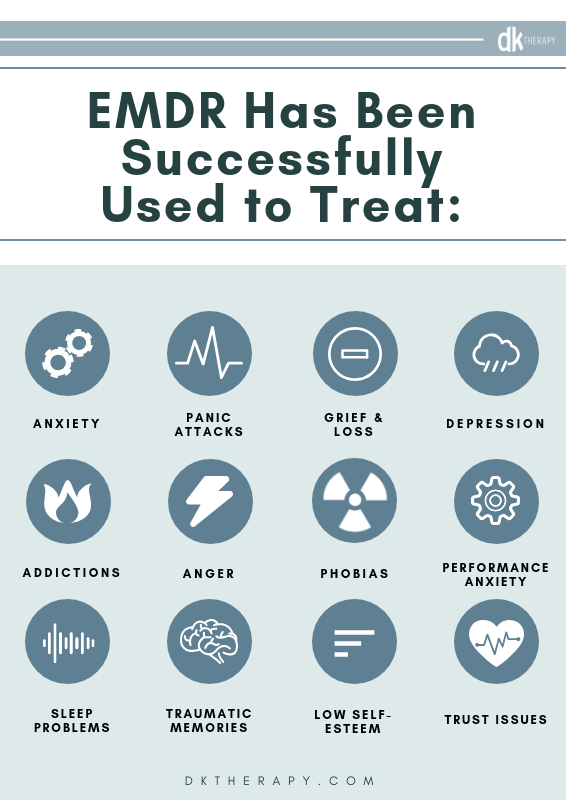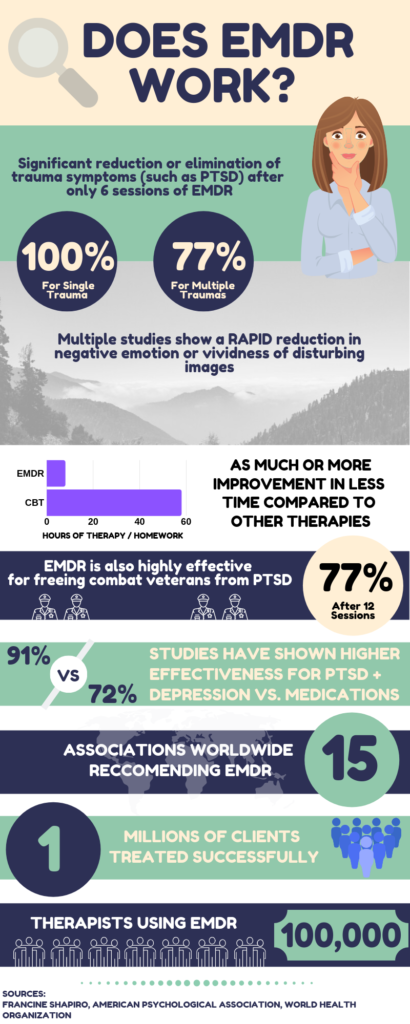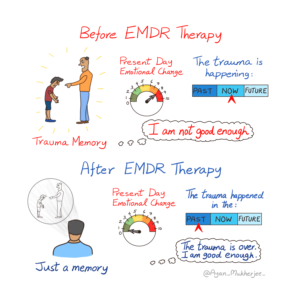EMDR therapy transforms lives – plain and simple. EMDR is a gift, it heals, it is effective and efficient, it has given meaning to my life beyond anything I could imagine, it keeps my work challenging and equally rewarding, and I don’t know what I would do without it.”
I am eternally grateful how EMDR therapy has changed the lives of my clients. I have humbly witnessed the sheer strength of the human soul, marveled at a life-changing session, felt great relief for my client at the other side of something horrible, and am honored to know the empowerment of healing a heart…all because of EMDR therapy.
As a strength-based clinician, with a direct, but compassionate style I have used EMDR therapy in my private practice for almost 25 years. I used it to resolve major past and recent traumatic events as well as the long standing life disturbing events that create a world of hurt for my clients. I have also found it to be helpful in life transitions such as divorce or managing difficulties in the workplace or relationships. With amazement, EMDR therapy has helped clients get beyond the obstacles of performing optimally in work, life and sport – whether professionally or for leisure.
If you are willing to take the first step and reach out to me, together we can conquer the emotional obstacles that stand in your way.

WHAT IS EMDR THERAPY?
Eye Movement Desensitization and Reprocessing, commonly known as EMDR therapy, is an integrative, comprehensive, evidenced-based psychotherapy approach proven effective for the treatment of trauma. EMDR therapy includes a set of standardized protocols that incorporates elements from many different treatment approaches. To date, EMDR therapy has helped millions of people of all ages relieve many types of psychological stress.
The primary focus of EMDR therapy is to allow the client, using bilateral stimulation (e.g., eye movement) to reprocess traumatic events or other emotional roadblocks, and ultimately become desensitized to the memories or obstacles which may be at the root of many problems. When we are subjected to life disturbing and traumatic events, our brains may not fully comprehend and process the totality of the situation. This failure to process events thoroughly often manifests itself as a debilitating psychological condition which can prevent us from living in the present moment. EMDR therapy stimulates the brain into reprocessing the events so that we may begin to reconcile them internally and desensitize ourselves to their traumatic nature. This enables and empowers us to once again be comfortable in our own skin.
EMDR therapy has also been found to effective treat other types of psychological conditions such as depression, anxiety, fears and phobias, somatic disorders and for stress management to name a few. It has also been used to help alleviate performance anxiety and to enhance the functioning of people at work and play. It helps to remove the emotional obstacles to performing optimally and enhances confidence and self-efficacy.
The three EMDR therapy professional organizations have compiled information and articles on EMDR therapy for the public and professionals.
The EMDR Research Foundation is a non profit organization raising money for high quality EMDR therapy research has several articles to explain EMDR therapy, history and what to expect.
EMDRIA is the professional organization for EMDR therapy clinicians also has information to increase public awareness of EMDR therapy.
Another brief overview of the EMDR therapy is provided by the Trauma Recovery/EMDR Humanitarian Assistance Program.
 How Does EMDR Work?
How Does EMDR Work?
Through EMDR, individuals safely reprocess traumatic information until it is no longer psychologically disruptive to their lives. There are 8 phases of treatment and in the Rapid Eye Movement phase, the individual focuses on a disruptive memory and identifies the belief they hold about themselves. If it is connected to this negative memory (for example, in dealing with abuse, the person may believe, “I deserved it”) the individual then formulates a positive belief that they would like to have (“I am a worthwhile and good person in control of my life.”). All the sensations and emotions that go along the memory are identified. The individual then reviews the memory while focusing on an external stimulus that creates bilateral eye movement. Typically this is done by watching the therapist move two fingers. After each set of bilateral movements, the individual is asked how they feel. This process continues until the memory is no longer disturbing to the individual. The individual is processing the trauma. The selected positive belief is then installed, via bilateral movement, to replace the negative belief.

Sessions typically last for an hour. It is theorized that EMDR works because the “bilateral stimulation” by-passes the area of the brain that processes memories has become stuck due to the trauma and is preventing the brain from proper processing and storage of the memory. During EMDR, individuals process the memory safely and that leads to a peaceful resolution resulting in increased insight regarding both previously disturbing event and the negative thoughts about themselves that have grown out of the original traumatic event.
 Who Uses EMDR Therapy?
Who Uses EMDR Therapy?
EMDR therapy has been endorsed by the American Psychiatric Association and the International Society for Traumatic Stress Studies. In addition, it is used by the United States Department of Veterans Affairs, the Department of Defense and overseas organizations, including the United Kingdom Department of Health and the Israeli National Council for Mental Health.
According to the EMDR Research Foundation there are now over 30 gold standard studies documenting the effectiveness of EMDR therapy over the past 30 years with problems such as rape and sexual abuse, combat trauma, childhood trauma and neglect, life threatening accidents, and symptoms such as anxiety, depression, and substance abuse.
Edy Nathan, MA, LCSW, is a licensed psychotherapist with over 20 years experience and has been certified as an EMDR practitioner, believes that this type of therapy has the ability to heal people who are suffering from all types of trauma. “What the technique does is shift the way we process the presence of the physical, emotional and psychological effects related specifically to a traumatic event,” she said. “The pain and sense of danger carried within the self after a traumatic event grips the soul with such purchase that it leads into a sense of being in emotional quicksand. EMDR works to disarm belief systems, also known as cognitions, and changes the negative cognition through a series of lateral eye movements, tapping or sound, while the client is asked to create the picture of pain and danger (trauma) that most disturbs them.”
Does EMDR Therapy Actually Work?
According to the EMDR Institute, Inc., some of the studies on this type of therapy show that 84%-90% of single-trauma victims no longer have post-traumatic stress disorder after only three 90-minute sessions. Another study, funded by the HMO Kaiser Permanente, found that 100% of the single-trauma victims and 77% of multiple trauma victims no longer were diagnosed with PTSD after only six 50-minute sessions. In another study, 77% of combat veterans were free of PTSD in 12 sessions.
What is also different about this type of therapeutic intervention is that the therapist the thes ot conversationally converse with the client while going through the process. After an EMDR session, clients can experience more vivid dreams, may sleep differently, might feel more sensitive to interactions with others or to external stimuli. This is all shared with the client at the end of each EMDR session.